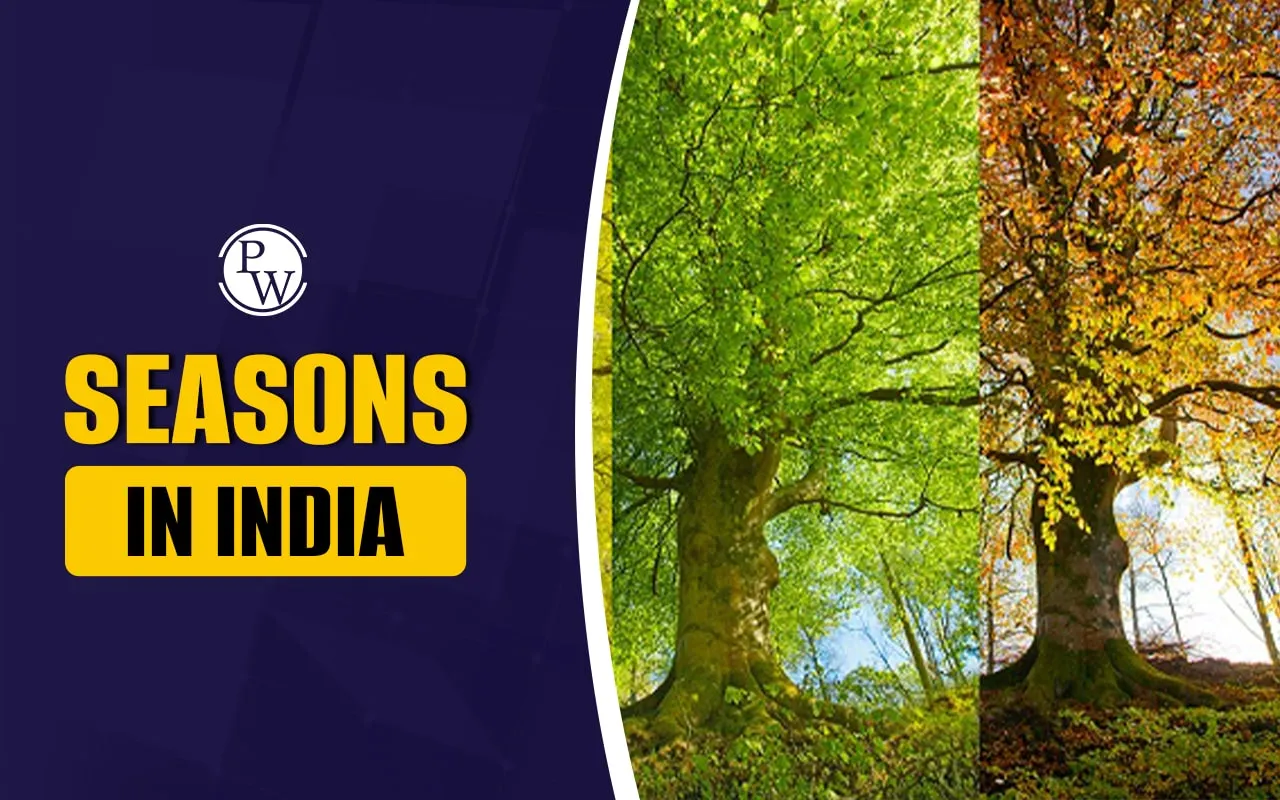

Seasons in India: India experiences a variety of climates due to its vast geography. The country has four main seasons: summer, monsoon, post-monsoon, and winter. These seasons in India affect not just weather but also agriculture, festivals, lifestyle, and economic activities. Keep reading to understand each of these seasons in India in detail.
Seasons in India
India has four main climatic seasons based on the Indian Meteorological Department (IMD). Here is the list of seasons in India with months:
| Season | Months | Information |
| Winter | December to early April | Coldest period, especially in north India |
| Summer / Pre-monsoon | April to June (April to July in North West India) | Hot and dry, heatwaves common |
| Monsoon / Rainy | June to September | Heavy rainfall across most of India |
| Post-monsoon | October to December | Transition period, some rain in south, October heat |
Each season arrives almost on the same dates every year due to the Earth’s tilt and revolution. Also, these seasons in India vary by region. For example, the Himalayan states have a longer winter, while the southern parts experience shorter winters. The timing and intensity of the monsoon season in India also differ from state to state.
Summer Season in India
The summer season in India begins around April and peaks in May and June. This season is known for its high temperatures, long days, and dry winds. The summer season in India is especially harsh in the northern plains and central India, where temperatures often cross 45°C, reaching as high as 48°C to 50°C.
In contrast, coastal areas and hill stations experience milder summers. This season affects daily life, with people avoiding going out in the afternoon. Heatwaves are common, and water shortages occur in many regions. Power cuts and crop failures are also frequent during extreme summer months.
Despite the heat, this season plays a key role in agriculture. It helps in preparing the land for Kharif crops. Many fruits like mangoes, watermelons, and litchis are summer fruits. Over the years, the summer season in India has become hotter due to urbanisation and climate change, with cities like Delhi and Nagpur recording higher temperatures than usual.
Monsoon Season in India
The monsoon season in India is officially known as the ‘seasonal reversal of winds’. It brings relief from the intense summer heat and is a lifeline for agriculture. This season typically lasts from June to September, followed by light rains during the post-monsoon period. It is caused by the southwest monsoon winds, which carry moisture from the Indian Ocean.
The monsoon season in India begins in Kerala and moves northward, covering the entire country by mid-July. Some regions, like the Western Ghats and Northeast India, receive heavy rainfall. A good monsoon ensures a good harvest and boosts the economy. However, excess rainfall can lead to floods and crop damage, while weak monsoons can cause droughts.
In recent years, the monsoon season in India has become unpredictable. Uneven rainfall, delayed onset, and sudden heavy showers are becoming common, affecting both urban and rural areas.
Winter Season in India
The winter season in India starts in December and lasts till April. This is the coldest period of the year. The winter season in India is pleasant in most regions, especially the south. But northern India can get very cold, with temperatures falling below 5°C in places like Delhi, Punjab, and even below minus in areas like Kashmir.
During this season, cold winds from the Himalayas blow towards the plains. Fog, mist, and frost are common in many regions. Festivals like Diwali, Christmas, and Lohri fall during this time. Though this season is mostly pleasant, extreme cold can harm poor communities and cause health issues. In some regions, snowfall cuts off road access, and daily life gets affected.
Like other seasons in India, the winter season in India is also shifting. Winters are becoming shorter and warmer due to global warming.
Cropping Seasons in India
Agriculture in India is closely tied to the seasons in India. Farmers plan their crops based on rainfall, temperature, and weather patterns. The main cropping seasons in India are Kharif, Rabi, and Zaid. Here is an overview of agriculture seasons in India:
| Season | Sowing / Duration | Harvesting | Major Crops | Key States | Climate |
| Rabi | October to December | April to June | Wheat, barley, peas, mustard, gram | Haryana, Punjab, Himachal Pradesh, Jammu & Kashmir, Uttarakhand, Uttar Pradesh | Cool and dry; relies on irrigation or residual moisture |
| Kharif | June to July (onset of southwest monsoon) | September to October | Rice, jowar, maize, bajra, tur (pigeon pea), moong, urad, cotton, jute, groundnut, soybean | West Bengal, Assam, Odisha, Andhra Pradesh, Telangana, Tamil Nadu, Kerala, Maharashtra | Warm and wet; dependent on monsoon rains |
| Zaid | March to July (between Rabi and Kharif) | Seasonal fruits, vegetables, fodder crops | Most northern and northwestern states | Hot and dry; crops grown with irrigation | |
So, the seasons in India are deeply connected to the lives of Indian farmers. Any change in weather patterns affects food production and the economy.
Impact of Climate Change on Seasons in India
Climate change is affecting all seasons in India. With rising temperatures and increasing weather extremes, traditional patterns are shifting, which is a serious challenge to livelihoods and food security. The impact of climate change on Indian seasons can be seen in:
-
Rising Temperatures: Summers are starting earlier and lasting longer, while winters are getting shorter and milder. The 2025 recorded the second-highest average temperature since 1901, with February 2025 being the warmest on record.
-
Erratic Monsoons: Unpredictable rainfall patterns with delayed onset, sudden downpours, and prolonged dry spells are becoming common.
-
Extreme Weather Events: India is witnessing more frequent heatwaves, floods, droughts, and unseasonal rains.
-
Agricultural Disruption: Shifting seasons and erratic weather are disturbing sowing and harvesting cycles, reducing crop yields.
-
Water and Health Challenges: Altered rainfall impacts water availability and increases the spread of waterborne and vector-borne diseases.
To reduce the impact, India is taking steps like promoting solar energy, improving irrigation, and spreading awareness. But more efforts are needed to protect the delicate balance of seasons in India.
Want to explore Indian Geography? Join PW’s UPSC Courses to strengthen your UPSC preparation today!
Seasons in India FAQs
Which are the seasons of india?
When does the summer season in India start?
What is the duration of the monsoon season in India?
How do NBFCs differ from banks?
Why is the financial system important?

UPSC Coaching












